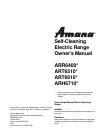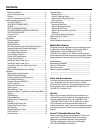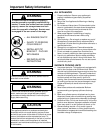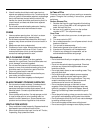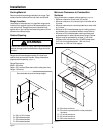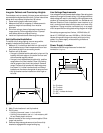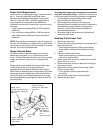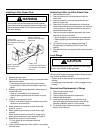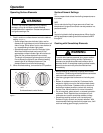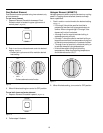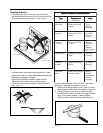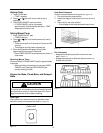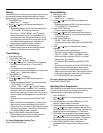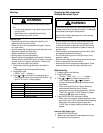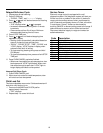
4
6. Utensil handles should be turned inward and not
extend over adjacent surface units. To reduce the risk
of burns, ignition of flammable materials, and spillage
due to unintentional contact with the utensil, the
handle of a utensil should be positioned so that it is
turned inward, and does not extend over adjacent
surface units.
7. Do not soak removable heating elements. Heating
elements should never be immersed in water.
OVENS
1. Use care when opening door. Let hot air or steam
escape before removing or replacing food.
2. Do not heat unopened food containers. Build-up of
pressure may cause container to burst and result in
injury.
3. Keep oven vent ducts unobstructed.
4. Placement of oven racks. Always place oven racks
in desired location while oven is cool. If rack is
removed while oven is hot, do not let potholder
contact hot heating element in oven.
SELF-CLEANING OVENS
1. Do not clean door gasket. The door gasket is
essential for a good seal. Care should be taken not
to rub, damage, or move the gasket.
2. Do not use oven cleaners. No commercial oven
cleaner or oven liner protective coating of any kind
should be used in or around any part of the liner.
3. Clean only parts listed in manual.
4. Before self-cleaning the oven, remove broiler pan,
oven racks, and other utensils.
5. Remove all items from rangetop and backguard.
GLASS/CERAMIC COOKING SURFACES
1. Do not cook on broken cooktop. If cooktop should
break, cleaning solutions and spillovers may
penetrate the broken cooktop and create a risk of
electrical shock. Contact a qualified technician
immediately.
2. Clean cooktop with caution. If a wet sponge or cloth
is used to wipe spills on a hot cooking area, be
careful to avoid a steam burn. Some cleaners can
produce noxious fumes if applied to a hot surface.
VENTILATION HOODS
1. Clean ventilation hoods frequently. Grease should not
be allowed to accumulate on hood or filter.
2. When flaming foods under hood, turn fan off. The fan,
if operating, may spread the flame.
In Case of Fire
Fires can occur as a result of over cooking or excessive
grease. Though a fire is unlikely, if one occurs, proceed
as follows:
Surface Element Fire
1. Smother the fire with a nonflammable lid or baking
soda, or use a Class ABC or BC extinguisher. Not
water. Not salt. Not flour.
2. As soon as it is safe to do so, turn the surface
controls to
OFF
. Turn off power supply.
Oven Fires
1. If you see smoke from your oven, do not open oven
door.
2. Turn oven control to
OFF
.
3. As an added precaution, turn off power at main circuit
breaker or fuse box.
4. Turn on vent to remove smoke.
5. Allow food or grease to burn itself out in oven.
6. If smoke and fire persist, call fire department.
7. If there is any damage to components, call an
authorized servicer before using range.
Precautions
• Do not cook food directly on rangetop surface, always
use cookware.
• Do not mix household cleaning products. Chemical
mixtures may interact with objectionable or even
hazardous results.
• Do not put plastic items on warm cooking areas. They
may melt and stick.
• Do not slide rough metal objects across rangetop
surface. Scratching or metal marking can result.
• Do not use cookware with rough bottoms. They may
scratch smoothtop surface. Glass and ceramic
cookware can be used on coil elements.
• Do not use damp sponge or dishcloth to clean
rangetop. A film of soil-laden detergent water may
collect on rangetop. If this should happen, Amana
Cleaning Conditioning Cream removes this type of
stain.
• Do not leave fat heating unless you remain nearby. Fat
can ignite if overheated by spilling onto hot surfaces.
• Do not allow pots to boil dry as this can cause damage
to cooking surface and pan.
• Do not use rangetop surface as a cutting board.
• Do not use range for storage or as a display counter.



